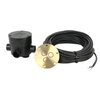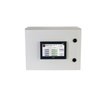Pavement Snow and Ice Sensor Kit (SIT–6E Sensor + Housing)
Snow Melting Sensors Description
This kit includes a pavement sensor for detecting snow and ice along with a specialized housing unit for the sensor.
The SIT–6E Pavement-Mounted Snow and Ice Sensor reliably detects snow and ice conditions on pavement surfaces when used with SC-MZ-TOUCH, SCA-DUAL, or SCP-120 controls. The SIT–6E pavement sensor ensures that deicing heaters operate only while needed which minimizes energy costs without sacrificing snow melting effectiveness.
As part of a snow melting system, a SIT–6E sensor will signal for snow and ice melting at pavement temperatures below 38°F (3.3°C) while moisture in any form—including water, snow, sleet or ice—is present.
It’s important for the sensor to be level with the pavement surrounding it. This is why a pavement sensor housing unit, ETI part number 23832 (included in this kit), is needed for each pavement sensor. This housing supports the sensor within the pavement and includes adjustment screws that allow proper leveling with the pavement surface.
For best results, consider using the SIT–6E pavement sensor together with an AIR-SS-2 aerial snow sensor. Including an AIR-SS-2 sensor will allow the snow/ice melting system to energize as soon as falling precipitation (e.g., snow or freezing rain) is detectable.
Sensor Features
- Control based upon pavement conditions
- Rugged construction
- Simple installation
- Low voltage operation
- Reliable snow melting
- Minimum energy cost
- Long trouble-free life
- NEC Class 2 for wet locations
Learn more about snow melting systems. Perfect for heated driveways, patios, walkways and paths, accessibility ramps, or even stairs.
Specifications
Electrical (SC-SS-PAV-6E)
| Activation Temperature | 38 °F |
| Lead Length | 60′ |
| Sensitivity | Temperature and precipitation |
| Voltage | 120 V |
Product Dimensions (SC-SS-PAV-6E)
| Coverage | 0.2005 ft² |
| Length | 5.25″ |
| Weight | 5.8 lbs |
| Width | 5.5″ |
Installation (SC-SS-PAV-6E)
| Installation Area | Pavement |
Product Dimensions (SC-SS-PAV-HS)
| Length | 5.25″ |
| Weight | 0.8 lbs |
| Width | 5.5″ |
Identifiers (SC-SS-PAV-6E)
| SKU | SC-SS-PAV-6E |
Identifiers (SC-SS-PAV-HS)
| SKU | SC-SS-PAV-HS |
Electrical (SC-SS-PAV-HS)
| Voltage | 120 V |
Warranty / Certifications (SC-SS-PAV-6E)
| Warranty | 2 years |
Warranty / Certifications (SC-SS-PAV-HS)
| Warranty | 2 years |
Documents
Frequently Asked Questions
The material costs are similar. However, electric systems are easier to install, with fewer components and significantly lower maintenance costs. Electric systems will run for a shorter period of time to give the same level of performance but with much higher energy efficiency (typically 95%-98% efficient). Controls and sensors required for the two types of systems are very similar. Electric systems do not usually require slab insulation and do not create the concerns typically associated with hydronic systems. These concerns include, but are not limited to, return temperatures, flue gas venting, waterway shrinkage and property damage caused by leaking pipes or tubes.
When installing outdoor WarmlyYours snow melting cables for your driveway, patio, walkway, terrace, stairs, ramp, etc. - NEVER cross, overlap, or allow the heating cables to touch each other. Doing so will quickly cause a circuit failure due to excessive heat build up. Always follow the installation instructions and/or design layout plan to ensure the cable is installed with the correct spacing required for proper operation.
Our systems can handle low temperatures, but many controls come equipped with a Low-Temperature Lockout Feature. This feature prevents the system from running in very low temperatures. At very low temperatures it can become difficult for the system to effectively melt the snow. It is however possible to turn off this feature should you need the system to keep running during such low temperatures.



















































